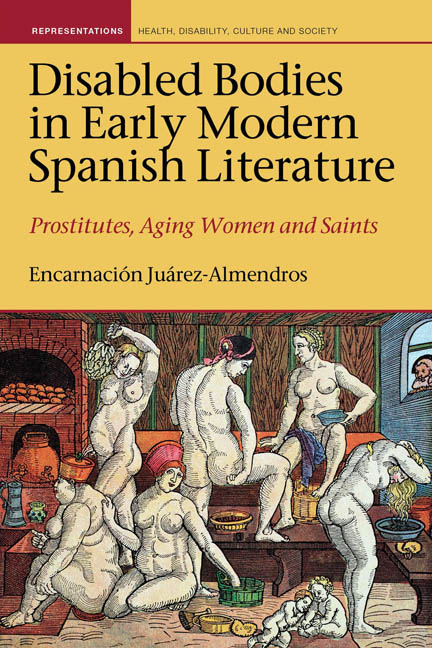Book contents
- Frontmatter
- Contents
- Acknowledgments
- Introduction
- I The Creation of Female Disability: Medical, Prescriptive and Moral Discourses
- II The Artifice of Syphilitic and Damaged Female Bodies in Literature
- III The Disabling of Aging Female Bodies: Midwives, Procuresses, Witches and the Monstrous Mother
- IV Historical Testimony of Female Disability: The Neurological Impairment of Teresa de Ávila
- Conclusion
- Works Cited
- Index
Conclusion
- Frontmatter
- Contents
- Acknowledgments
- Introduction
- I The Creation of Female Disability: Medical, Prescriptive and Moral Discourses
- II The Artifice of Syphilitic and Damaged Female Bodies in Literature
- III The Disabling of Aging Female Bodies: Midwives, Procuresses, Witches and the Monstrous Mother
- IV Historical Testimony of Female Disability: The Neurological Impairment of Teresa de Ávila
- Conclusion
- Works Cited
- Index
Summary
Disabled Bodies in Early Modern Spanish Literature: Prostitutes, Aging Women and Saints responds to an inquiry about what constitutes disability in early modern Spanish culture. Following an examination of diverse existing Spanish discourses in the period that reproduce concepts developed in the Western tradition it becomes clear that the pejorative creation of the woman's body—and the complex detrimental reverberation of this construction in the historical reality as well as in the artistic realm—is the epitome of early modern disability.
The publication of La Celestina at the end of the fifteenth century coincides with the outbreak of syphilis and an increase in violence towards and the subjugation of women. In this book, Celestina, a sixty-year-old prostitute, advances the plot. Her decayed body parallels her immoral and subversive attitude, and her actions complicate the accepted medieval social order. Celestina's embodiment illustrates the reality of destitute old women in the period, as well as the decline of established female professions in the field of traditional healing in competition with the new, powerful, professionalized male medicine. Celestina had a major impact in the artistic imagination, as the abundant publications with similar protagonists during the sixteenth and seventeenth centuries corroborate. This female figure inaugurated the installation of the damaged and rejected body at the center of Renaissance literary innovation. The son of a prostitute, the protagonist of Lazarillo de Tormes, the fictive picaresque autobiography published in 1554, adds to the narrative revolution started by La Celestina. The flourishing genre of the picaresque relies on emaciated hungry bodies and socially castrated individuals, where protagonists of both genders are outcasts and feminized. They are the extension and consequence of the imperfect and immoral prostitute–witch–mother. Nevertheless, the deviant and desiring bodies of Celestina and Lázaro become the impulse of the new European narrative, the realistic novel. Disease, hunger, decay and aging substituted the aristocratic, strong and beautiful bodies of medieval knights and damsels, and ideal love was contested by fornication.
By the beginning of the seventeenth century the two most widely read novels in Spain, Guzmán de Alfarache (1599, 1604), a picaresque novel with an impotent and corrupt roguish protagonist, and Don Quixote de la Mancha (1605, 1615), the narration of a mad hidalgo, place somatic imperfection at the thrust of the story.
- Type
- Chapter
- Information
- Disabled Bodies in Early Modern Spanish LiteratureProstitutes, Aging Women and Saints, pp. 167 - 169Publisher: Liverpool University PressPrint publication year: 2017



